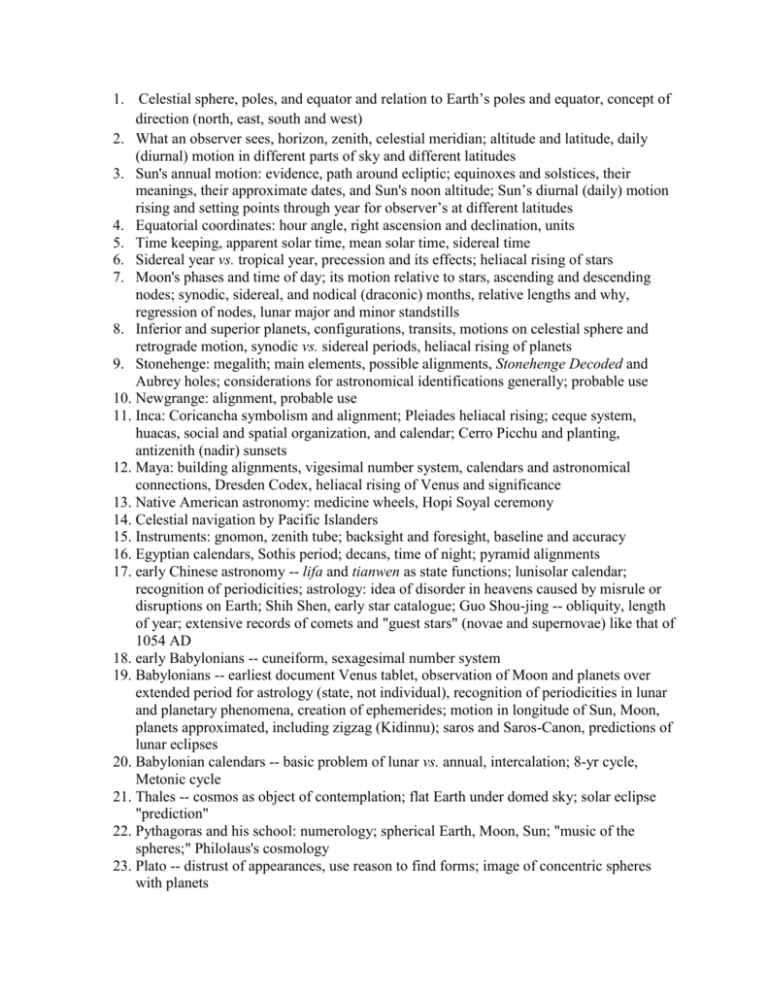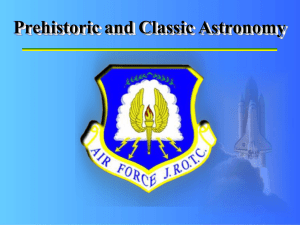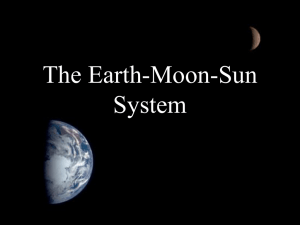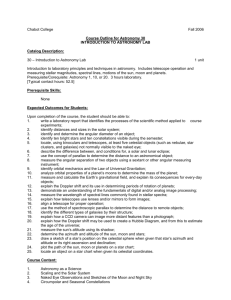AST 3043 topic list
advertisement

1. Celestial sphere, poles, and equator and relation to Earth’s poles and equator, concept of direction (north, east, south and west) 2. What an observer sees, horizon, zenith, celestial meridian; altitude and latitude, daily (diurnal) motion in different parts of sky and different latitudes 3. Sun's annual motion: evidence, path around ecliptic; equinoxes and solstices, their meanings, their approximate dates, and Sun's noon altitude; Sun’s diurnal (daily) motion rising and setting points through year for observer’s at different latitudes 4. Equatorial coordinates: hour angle, right ascension and declination, units 5. Time keeping, apparent solar time, mean solar time, sidereal time 6. Sidereal year vs. tropical year, precession and its effects; heliacal rising of stars 7. Moon's phases and time of day; its motion relative to stars, ascending and descending nodes; synodic, sidereal, and nodical (draconic) months, relative lengths and why, regression of nodes, lunar major and minor standstills 8. Inferior and superior planets, configurations, transits, motions on celestial sphere and retrograde motion, synodic vs. sidereal periods, heliacal rising of planets 9. Stonehenge: megalith; main elements, possible alignments, Stonehenge Decoded and Aubrey holes; considerations for astronomical identifications generally; probable use 10. Newgrange: alignment, probable use 11. Inca: Coricancha symbolism and alignment; Pleiades heliacal rising; ceque system, huacas, social and spatial organization, and calendar; Cerro Picchu and planting, antizenith (nadir) sunsets 12. Maya: building alignments, vigesimal number system, calendars and astronomical connections, Dresden Codex, heliacal rising of Venus and significance 13. Native American astronomy: medicine wheels, Hopi Soyal ceremony 14. Celestial navigation by Pacific Islanders 15. Instruments: gnomon, zenith tube; backsight and foresight, baseline and accuracy 16. Egyptian calendars, Sothis period; decans, time of night; pyramid alignments 17. early Chinese astronomy -- lifa and tianwen as state functions; lunisolar calendar; recognition of periodicities; astrology: idea of disorder in heavens caused by misrule or disruptions on Earth; Shih Shen, early star catalogue; Guo Shou-jing -- obliquity, length of year; extensive records of comets and "guest stars" (novae and supernovae) like that of 1054 AD 18. early Babylonians -- cuneiform, sexagesimal number system 19. Babylonians -- earliest document Venus tablet, observation of Moon and planets over extended period for astrology (state, not individual), recognition of periodicities in lunar and planetary phenomena, creation of ephemerides; motion in longitude of Sun, Moon, planets approximated, including zigzag (Kidinnu); saros and Saros-Canon, predictions of lunar eclipses 20. Babylonian calendars -- basic problem of lunar vs. annual, intercalation; 8-yr cycle, Metonic cycle 21. Thales -- cosmos as object of contemplation; flat Earth under domed sky; solar eclipse "prediction" 22. Pythagoras and his school: numerology; spherical Earth, Moon, Sun; "music of the spheres;" Philolaus's cosmology 23. Plato -- distrust of appearances, use reason to find forms; image of concentric spheres with planets 24. Eudoxus -- mathematical model: concentric spheres centered on Earth, hippopede; problems 25. Aristotle -- geocentric physical model based on Eudoxus; arguments for spherical Earth; argument of fall; argument against Earth's orbiting Sun; quinta essentia and immutability; ideas about comets and meteors; ideas about motion; approximate date 26. Heraclides -- Earth's rotation; Mercury and Venus orbit Sun 27. Aristarchus -- Hellenistic astronomy; relative distances of Sun and Moon; dimensions of Sun and Moon relative to Earth; heliocentric model; approximate date 28. Eratosthenes -- position; circumference of Earth 29. Hipparchus -- star catalogue with celestial longitudes and latitudes, magnitudes; discovery of precession; inequality of seasons and Sun's orbit; Moon's orbit; Moon's geocentric parallax; accurate lengths of various kinds of months and of year; approximate date 30. Ptolemy -- geocentric model using epicycles (Apollonius), equant and other problems; Matematike syntaxis and Tetrabiblos: tables for predicting positions of Sun, Moon, planets; refinement and extension of Hipparchus's work, including geocentric parallaxes of Sun and Moon; astrology; Planetary Hypotheses; approximate date 31. importance of astronomy in Islamic lands -- calendar, timekeeping (muwaqqit), direction to Mecca (qibla), astrology (zij) 32. Caliph al-Ma'mun and the House of Wisdom, al-Khwarizmi, translation -- Almagest, approximate date 33. Thabit ibn-Qurra -- critic of Ptolemy, trepidation (based on erroneous data) 34. Muhammad al-Battani (Albategnius) -- introduction of sines, spherical trigonometry; improved Ptolemaic model, especially solar orbit 35. Abd al-Rahman al-Sufi -- used Ptolemy's catalogue with improved magnitudes for star maps -- Book on Constellations of Fixed Stars 36. Abd al-Rahman Ibn Yunus -- observer, large instruments; Hakemite Tables included observations of eclipses and conjunctions; fairly good value for atmospheric refraction 37. Ibn al-Haytham (Alhazen) -- critic of Ptolemy, On the Configuration of the World; book on optics 38. Nasir al-Din al-Tusi -- Maragha Observatory, revised Ptolemy's model of motion in latitude; eliminated equant by using two extra epicycles; eliminated eccentric; Ilkhanic Tables 39. Ibn al-Shatir -- eliminated equant by introducing extra epicycle; refined Moon's motion 40. Ulugh Beg -- Samarkand Observatory; star catalogue with newly-measured positions 41. Ibn al-Zarqala (Arzachel) -- Toledo Tables 42. Alfonsine Tables -- origin of name; Isaac ben Said and Jehuda ben Moses Cohen; precession and trepidation; significance; approximate date 43. ecliptic coordinates: definitions, units 44. naked-eye instruments -- gnomon; armillary sphere (equatorial and zodiacal); astrolabe; mural quadrant, hand-held quadrant; triquetrum (three-staff) 45. Medieval criticism of Aristotle's theory of motion -- Buridan, Oresme; impetus, argument of fall 46. Sacrobosco (John of Holywood) -- medieval texts on astronomy, esp. Tractatus de sphaera 47. dichotomy both in Islamic thought and in late medieval cosmology -- Aristotle vs. Ptolemy 48. Georg Peurbach (or Purbach) -- New Theory of the Planets, Epitome of Ptolemy (with Regiomontanus) 49. Regiomontanus (Johannes Mueller) -- pupil of Peurbach; Epitome (with Peurbach); Ephemerides 50. Bernhard Walther -- pupil of Regiomontanus; extensive series of fairly accurate observations; rediscovered atmospheric refraction 51. Nicolaus Copernicus -- background; dissatisfaction with Ptolemaic model; Brief Commentary, On the Revolutions and his model, true place of Sun; roles of Rheticus (Georg Joachim) and Osiander; significance; approximate date 52. Erasmus Reinhold -- Prutenic Tables 53. Tycho Brahe -- background; "new star" of 1572 and comet of 1577; observations from Uraniborg and Stjerneborg; treatment of refraction; Tychonic theory 54. Johannes Kepler -- background; Cosmographic Mystery, New Astronomy; Survey of Copernican Astronomy and Harmony of the World, laws of planetary motion; Rudolphine Tables; approximate date 55. Galileo Galilei -- background; correspondence with Kepler; Starry Messenger and discoveries with telescope; Letter to Grand Duchess Christina and consequences; Dialogue on the Two Great World Systems and consequences; Discourses on Two New Sciences 56. Francis Bacon: experimental philosophy, inductive method; New Atlantis, organization of science; practical application of science 57. Rene Descartes: critical doubt; deductive method and use of reason, Principles of Philosophy, plenum, vortices, theory of comets, infinite universe 58. scientific societies -- Accademia dei Lincei and Accademia del Cimento (Italy), Royal Society (England) and Robert Hooke, Academie des Sciences (France); publications 59. Christiaan Huygens: "aerial" telescope; Saturn's rings and large satellite; centripetal force; pendulum clock 60. G. D. Cassini: first director Paris Observatory, 4 small satellites of Saturn, Cassini Division 61. Hevelius: lunar map; accurate positions without telescope, dispute with Hooke 62. Newton: origin; calculus (ind. Leibniz); optics -- dispersion into colors; Philosophiae naturalis principia mathematica: methodology, laws of motion, universal gravitation, two-body problem, Moon's motion including regression, Earth's oblateness, tides, precession, test of vortex theory; approximate date 63. Halley: role in publication of Principia; Southern Hemisphere stars; second Astronomer Royal; comet orbits; proper motions of stars 64. Flamsteed: first Astronomer Royal, Royal Greenwich Observatory; Britannic History of the Heavens (star catalogue) 65. Roemer: speed of light from eclipses of Jupiter's satellites, right ascension and declination at transit 66. shape of Earth -- oblate vs. prolate, measurements of degree of latitude -- Bouguer and La Condamine, Maupertuis 67. Bradley: third Astronomer Royal; aberration of starlight; nutation 68. naked-eye instruments -- cross-staff (Levi ben Gerson), nocturnal; Brahe's innovations 69. telescopes -- Galilean refractor, Kepler (astronomical) refractor, and their respective advantages and disadvantages; reflector (Newton, Cassegrain) and its advantages and disadvantages; zenith sector, transit telescope 70. chromatic and spherical aberration









